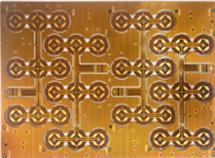In the design of electromagnetic interference for electronic products, developers are increasingly aware of the importance of EMI processing in PCB circuits. If the EMI problem can be suppressed at this stage, then about 60% of the interference problem can be solved. So how to maximize interference suppression in the circuit board design process?
Rule 1: High-speed signal routing shielding rules
In high-speed PCB design, key high-speed signal lines such as clocks and traces need to be shielded. If there is no shield or only part of it, it will cause EMI leakage. It is recommended that the shielded wire be grounded with a hole per 1000 mil.
Rule 2: Closed-loop routing rules for high-speed signals
Due to the increasing density of PCB boards, many PCBLAYOUT engineers are prone to a mistake in the process of routing, that is, high-speed signal networks such as clock signals produce closed-loop results when routing multi-layer PCBs. The result of such a closed loop will produce a loop antenna and increase the radiated intensity of EMI.
Rule 3: Open-loop routing rules for high-speed signals
Rule 2 mentions that the closed loop of high-speed signals will cause EMI radiation, but the open loop will also cause EMI radiation.
For high-speed signal networks such as clock signals, once an open-loop result occurs when a multilayer PCB is routed, a linear antenna will be generated, which will increase the EMI radiation intensity.

Rule 4: Characteristic impedance continuity rule of high-speed signal
For high-speed signals, it is necessary to ensure the continuity of characteristic impedance when switching between layers, otherwise it will increase EMI radiation. In other words, the width of the wiring of the same layer must be continuous, and the impedance of the wiring of different layers must be continuous.
Rule 5: Wiring direction rules for high-speed PCB design
The wiring between two adjacent layers must follow the principle of vertical wiring, otherwise it will cause crosstalk between the lines and increase EMI radiation. In short, adjacent wiring layers follow the horizontal and vertical wiring directions, and vertical wiring can suppress crosstalk between lines.
Rule 6: Topological structure rules in high-speed PCB design
In high-speed PCB design, the control of the characteristic impedance of the circuit board and the design of the topology under the multi-load situation directly determine the success or failure of the product.
Rule 7: Resonance rule of trace length
Check whether the length of the signal line and the frequency of the signal constitute resonance, that is, when the length of the wiring is an integer multiple of the signal wavelength 1/4, the wiring will resonate, and the resonance will radiate electromagnetic waves and cause interference.
Rule 8: Return path rules
All high-speed signals must have a good return path. As much as possible to ensure that the return path of high-speed signals such as clocks is minimized. Otherwise it will greatly increase the radiation, and the size of the radiation is proportional to the area enclosed by the signal path and the return path.
Rule 9: Decoupling capacitor placement rules for devices
The location of the decoupling capacitor is very important. Unreasonable placement will not have the effect of decoupling at all. The principle is: close to the pin of the power supply, and the area enclosed by the power trace and the ground wire of the capacitor is the smallest.
As long as these nine rules are followed in the PCB design process, most of the interference can be successfully avoided before the formal control of EMI, which provides great convenience for the follow-up work.